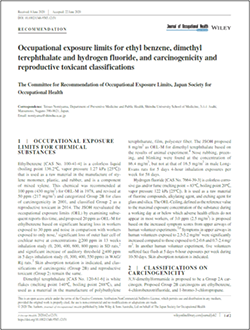#0071 Occupational exposure limits for ethyl benzene, dimethyl terephthalate and hydrogen fluoride, and carcinogenicity and reproductive toxicant classifications

Updating safe exposure limits for toxic chemicals based on workplace hazard reassessment
A lot of the chemical compounds that are useful for manufacturing products with daily life applications like plastic and rubber are often hazardous to the workers exposed to them. Assessing and managing the health risks arising from exposure to such chemicals is, therefore, crucial. Consequently, occupational health programs are put in place to categorize the toxicity of potentially hazardous chemicals, set their occupational exposure limits (OEL), and update these standards over time based on subsequent reports of worker health.
In this study, we re-evaluated the OEL-mean (OEL-M), or the mean concentration at or below which no adverse health effects arise for a number of chemical compounds, notably ethylbenzene, dimethyl terephthalate, and hydrogen fluoride, along with classifying them on their carcinogenicity (ability to cause cancer) and reprotoxicity (effect on sexual function and fertility).
For ethylbenzene, we lowered the OEL-M from 50 ppm (parts per million, or milligrams per liter of water) to 20 ppm based on reports of hearing loss in workers exposed to 30 ppm and auditory nerve damage in rats. For dimethyl terephthalate, we proposed an OEL-M of 8 milligrams per cubic meter (1 ppm) after finding instances of skin and eye irritation in rats exposed to a concentration of 86 milligrams per cubic meter (10 ppm). As for hydrogen fluoride, we set the OEL-Ceiling to 2.5 milligrams per cubic meter (3 ppm) based on increased symptoms of upper airway irritation in human volunteers exposed to (2.5-5) milligrams per cubic meter. In addition, we classified ethylbenzene as a Group 2B carcinogen and a Group 2 reproductive toxicant, which were the same as the classifications made in 2001 and 2014, respectively.
Based on our assessments, we conclude that it is necessary to re-examine the set standards for healthy workplace environments regularly in order to keep in step with the evolution of workplace hazards.

Link to the original journal article:
https://onlinelibrary.wiley.com/doi/full/10.1002/1348-9585.12151
Title of the paper:
Occupational exposure limits for ethyl benzene, dimethyl terephthalate and hydrogen fluoride, and carcinogenicity and reproductive toxicant classifications
Authors:
Atsuko Araki, Kenichi Azuma, Ginji Endo, Yoko Endo, Tetsuhito Fukushima, Kunio Hara, Hajime Hori, Masayoshi Ichiba, Tatsuya Ishitake, Gaku Ichihara, Akiyoshi Ito, Yuki Ito, Satoko Iwasawa, Takeyasu Kakamu, Michihiro Kamijima, Kanae Karita, Takahiko Katoh, Toshio Kawai, Toshihiro Kawamoto, Reiko Kishi, Shinji Kumagai, Yukinori Kusaka, Muneyuki Miyagawa, Hiroyuki Miyauchi, Yasuo Morimoto, Kasuke Nagano, Hisao Naito, Tamie Nakajima, Makiko Nakano, Tetsuo Nomiyama, Hirokazu Okuda, Masayuki Okuda, Kazuyuki Omae, kazuhiro Sato, Tomotaka Sobue, Yasushi Suwazono, Toru Takebayashi, Tatsuya Takeshita, Teruomi Tsukahara, Masashi Tsunoda, Jun Ueyama, Yumi Umeda, Kenya Yamamoto, Yuko Yamano, Takenori Yamauchi, and Eiji Yano




